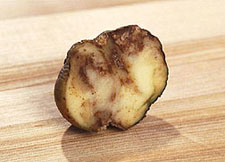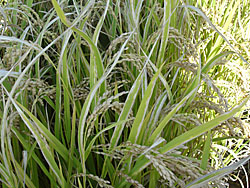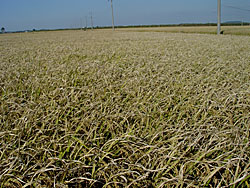Historical Perspectives of Plant Diseases
Over the centuries, many diseases and environmental changes have wiped out whole fields of crops; e.g., potato blight in the1800’s, corn leaf blight – 1900’s, cherry trees in northern Colorado in the 1950’s.
Potato Blight
The Irish Famine of 1846-50, which was the result of potato blight, took as many as one million lives from hunger and disease, and changed the social and cultural structure of Ireland in profound ways. For instance, during and after the potato blight invasion in Ireland many people emigrated to the US in order to create a better life for themselves. This altered the social environment of both Ireland and the United States.
 |
 |
| Figure 31 - Potato with blight |
Figure 32. A starving Irish family
(click to enlarge) |
Southern Corn Leaf Blight
 |
|
Figure 33 - Southern corn leaf blight
(click to enlarge) |
Southern corn leaf blight, caused by Race T of the fungus Bipolaris (Helminthosporium) maydis, forced US crop breeders to consider the detrimental effects of planting only one genotype of a crop. If the specific genotype used isn’t resistant to a particular invader, then the whole crop could be lost if the pathogen establishes itself in the environment. The B. maydis fungus that ravaged corn fields resulted in withered plants, broken stalks, and malformed or completely rotten cobs that were covered in a grayish powder. In 1970, almost 85% of US corn fields was planted with one type of corn, called Texas cytoplasmic male sterile (Tcms) corn. Unfortunately, this type of corn was highly susceptible to a new type (race) of the pathogenic fungus B. maydis race T. A combination of very wet weather conditions and the high susceptibility of the Tcms corn to B. maydis race T led to rapid spread of the pathogen and a devastating epidemic. The losses of corn were catastrophic, reaching as high as 50-100% in some areas of the US. The actual food energy losses were considered to be greater than those caused by the potato late blight epidemic of the 1840's. The economic losses from southern corn leaf blight disease totaled about 1 billion dollars.
This catastrophic loss highlighted the dangers or growing crops with limited genetic variation. "Never again should a major cultivated species be molded into such uniformity that it is so universally vulnerable to attack by a pathogen, an insect, or environmental stress. Diversity must be maintained in both the genetic and cytoplasmic constitution of all important crop species." (A. J. Ullstrup 1972 The impacts of the southern leaf corn blight epidemics of 1970-1971. Annual Reviews)
In this example it was possible for breeders and farmers to return to growing the corn seed that was not susceptible to this fungus. In other instances where disease attacks crops, there is no other source of resistance in the available population. The importance of having access to other, often much older germplasm from other regions of the world or from related species has been recognized as providing access to genes that may be used for future improvement of crops. "So maintaining a biodiverse ecosystem, with many varieties of plants and animals, is like having a living insurance policy to help protect those crops and creatures we humans depend upon for our survival”. (Jim Metzner, American Museum of Natural History).
The National Center for Genetic Resources Preservation program (NCGRP) which is located on the Colorado State University campus conserves genetic resources of crops important to US agriculture and landscapes. Preservation of genetic diversity in ex-situ gene banks such as NCGRP is important for conservation of biological diversity and utilization of genetic resources for economic and environmental sustainability. The mission of the center is:
“To acquire, assess, preserve and provide a collection of genetic resources to secure the biological diversity that underpins economic and environmental sustainability of agriculture through research, stewardship, and communications”.
This very important facility is renowned throughout the world for its work to ensure that future generations will have access to genetic material that may be important in developing crops and ornamental plants able to adapt to a changing world.
You can find more information about this exciting resource at: http://www.ars.usda.gov/main/site_main.htm?modecode=54-02-05-00
Bacterial Leaf Blight in Rice
 |
 |
Figure 34 - Bacterial leaf blight of rice
(click to enlarge) |
Figure 35 - Bacterial blight-affected rice field
(click to enlarge) |
In the early 1960’s a dwarf rice cultivar IR8, which had high yields, was non-lodging (lodging means that plants fall over when the stems collapse due to environmental conditions, disease or insect attack), and had good response to nitrogen was planted throughout Southeast and South Asia. Unfortunately, this cultivar was also very susceptible to bacterial leaf blight caused by Xanthomonas oryzae pv. oryzae. Since the pathogen was endemic in the region amongst the moderately resistant native cultivars, an epidemic of the disease occurred. In fields planted with high yield varieties, bacterial blight often cut yields by 20 to 50 percent throughout the 1960s. All over Southeast Asia, epidemics broke out, with loss of yields as high as 80 percent in some areas.
The problems were compounded by the fact that the pathogen changes quickly to overcome resistance, especially under monoculture conditions. Uniform crops exert selection pressure on the pathogen, and those pathogen strains for which the rice has no defense end up quickly dominating the populations.
By collecting farmer varieties and "wild" material throughout the world, the International Rice Research Institute (IRRI) in the Philippines has now identified around 2,200 lines resistant to bacterial blight. The bulk of these varieties come from three geographic centers: one in the area comprising Bangladesh, Nepal and North-East India, a second in Southern India and Sri Lanka, and a third in Java and the surrounding islands.
By incorporating these resistant varieties into their breeding program, IRRI has managed to keep infection to bacterial blight at manageable levels, with the exception of the occasional outbreak. The situation, however, is far from stable and IRRI remains in a race to, as it says, "stay one step ahead of bacterial blight."
How do we introduce genes into plants that allow them to become more resistant to invasion by pathogens?
Go to Activity 4 (Transformation of E. coli)
Go to Activity 5 (Plant tissue culture)
